Virtual Reality in Speech Therapy Students’ Training: A Scoping Review
Abstract
1. Introduction
1.1. Background
1.1.1. Training in Speech Therapy
1.1.2. Virtual Reality-Based Simulation
1.2. Rationale
1.3. Objectives
- How is virtual reality being used in the education and clinical training of speech–language pathology students?
- What are the educational, technological, and methodological characteristics of VR-based interventions in speech–language pathology training?
- What outcomes and benefits are reported in the literature regarding the use of VR in the training of speech–language pathology students? How are these assessed?
2. Materials and Methods
2.1. Protocol and Registration
2.2. Eligibility Criteria
- The study was targeted towards students or trainees in the speech therapy and language pathology field. The research encompassed studies that either directly targeted ST students or incorporated them within larger mixed cohorts.
- The study involved the use of virtual reality (including immersive, semi-immersive, and non-immersive formats) or it assessed or evaluated the use of the VR technology.
- The purpose was the education and/or training of students. Furthermore, studies analysing the effects of VR-based tools on students from different perspectives (i.e., from educators’ or students’ points of view) were considered as well.
2.3. Information Sources
2.4. Search
2.5. Selection of Sources of Evidence
2.6. Data-Charting Process
2.7. Data Items
2.8. Critical Appraisal of Individual Sources of Evidence
2.9. Synthesis of Results
3. Results
3.1. Selection of Sources of Evidence
3.2. Characteristics of Sources of Evidence
3.3. Critical Appraisal Within Sources of Evidence
3.4. Results of Individual Sources of Evidence
3.5. Synthesis of Results
3.5.1. Virtual Reality—Type and Characteristics
3.5.2. Population
3.5.3. Training Purposes (And Sub-Fields of Application)
3.5.4. Main Outcomes and Assessment Methods
4. Discussion
4.1. Summary of Evidence
4.1.1. General Overview
4.1.2. VR and Training Purposes
4.1.3. VR-Based Learning and Speech Therapy
4.2. Limitations
5. Conclusions
Author Contributions
Funding
Institutional Review Board Statement
Informed Consent Statement
Data Availability Statement
Acknowledgments
Conflicts of Interest
Abbreviations
| VR | Virtual Reality |
| ST | Speech Therapy |
| SLT | Speech and Language Therapy |
| SLP | Speech and Language Pathology |
| FEES | Flexible Endoscopic Evaluation of Swallowing |
| tDCS | Transcranial Direct-Current Stimulation |
| TTM | Tracheostomy Tube Management |
| TCM | Tracheal Cannula Management |
| CFCC | Council for Clinical Certification in Audiology and Speech–Language Pathology |
| ASHA | American Speech–Language–Hearing Association |
| CAPCSD | Council of Academic Programs in Communication Sciences and Disorders |
| VICSR | Virtual Immersion Center for Simulation Research |
| HMD | Head-Mounted Display |
| SLHS | Speech–Language and Hearing Sciences |
| OMA | Oral Musculature Assessment |
Appendix A
Appendix A.1. Title
Appendix A.2. Abstract
Appendix A.3. Keywords
Appendix A.4. Introduction
Appendix A.4.1. Background
Appendix A.4.2. Rationale
Appendix A.4.3. Objectives
Appendix A.5. Review Questions
- How is virtual reality being used in the education and clinical training of speech–language pathology students?
- What are the educational, technological, and methodological characteristics of VR-based interventions in speech–language pathology training?
- What outcomes and benefits are reported in the literature regarding the use of VR in the training of speech–language pathology students? How are these assessed?
Appendix A.6. Inclusion Criteria
Appendix A.6.1. Population
Appendix A.6.2. Concept
Appendix A.6.3. Context
Appendix A.6.4. Types of Sources
Appendix A.7. Methods
Appendix A.7.1. Search Strategy
Appendix A.7.2. Study/Source of Evidence Selection
- Title and abstract screening.
- Full-text review.
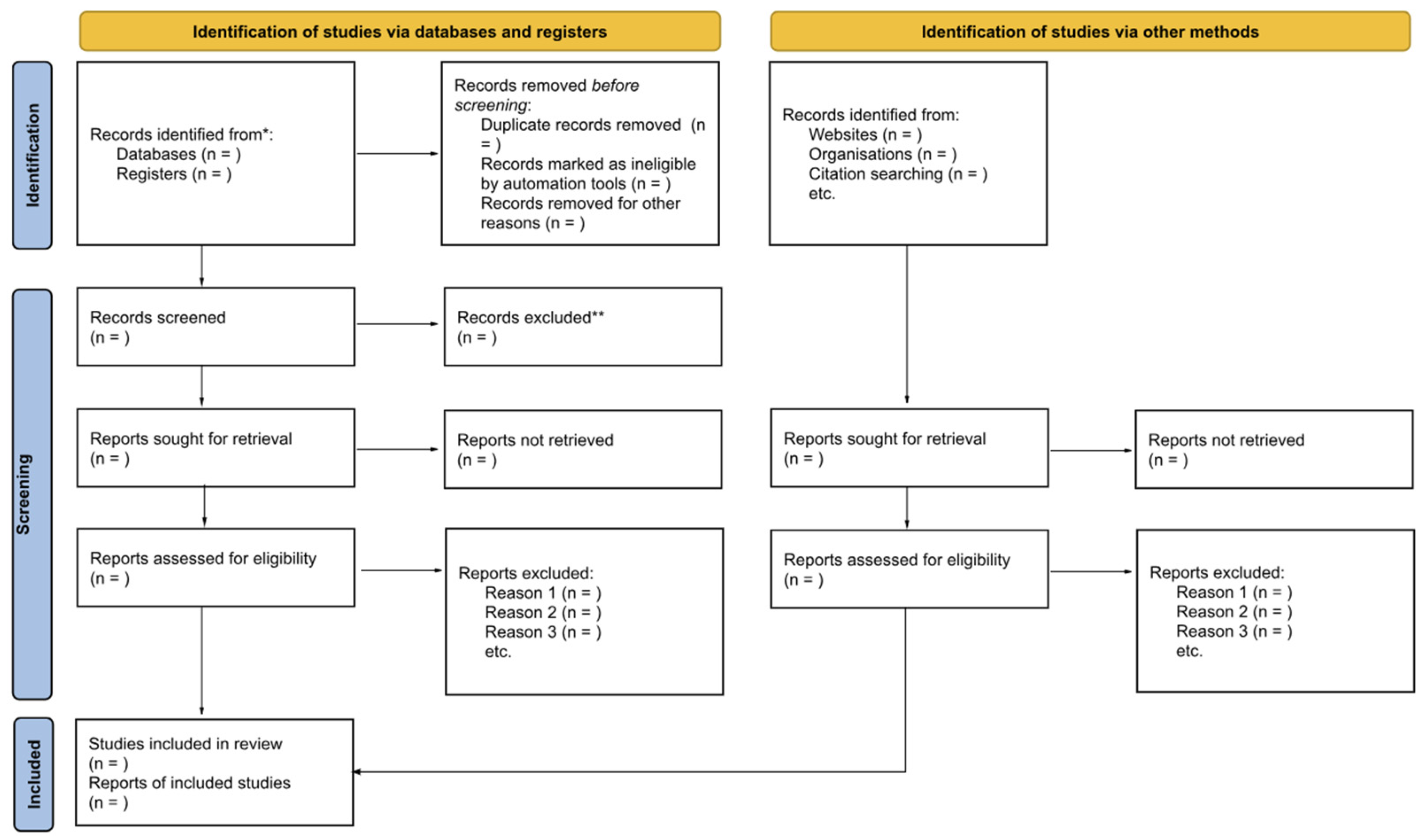
Appendix A.7.3. Data Extraction
Appendix A.7.4. Data Analysis and Presentation
Appendix A.8. Conflicts of Interest
Appendix A.9. Funding
Appendix A.10. Acknowledgements
Appendix A.11. References
- OECD (2025). What Do We Know about Young People’s Interest in Health Careers?. OECD Publishing, Paris. https://doi.org/10.1787/002b3a39-en
- Health Workforce (HWF), WHO Headquarters (HQ). (2013). Transforming and scaling up health professionals’ education and training. World Health Organization. https://www.who.int/publications/i/item/transforming-and-scaling-up-health-professionals%E2%80%99-education-and-training (accessed on 7 August 2025).
- World Health Organization. (2016). Global strategy on human resources for health: Workforce 2030. World Health Organization. https://iris.who.int/handle/10665/250368 (accessed on 7 August 2025).
- European Education and Culture Executive Agency: Eurydice. (2024). The European higher education area in 2024: Bologna process implementation report. Publications Office of the European Union. https://data.europa.eu/doi/10.2797/483185 (accessed on 7 August 2025).
- Christmas, C., & Rogus-Pulia, N. (2019). Swallowing Disorders in the Older Population. Journal of the American Geriatrics Society, 67(12), 2643–2649. https://doi.org/10.1111/jgs.16137
- Nagdee, N., Sebothoma, B., Madahana, M., Khoza-Shangase, K., & Moroe, N. (2022). Simulations as a mode of clinical training in healthcare professions: A scoping review to guide planning in speech-language pathology and audiology during the COVID-19 pandemic and beyond. South African Journal of Communication Disorders, 69(2). https://doi.org/10.4102/sajcd.v69i2.905
- Peters MDJ, Godfrey C, McInerney P, Munn Z, Tricco AC, Khalil, H. Scoping Reviews (2020). Aromataris E, Lockwood C, Porritt K, Pilla B, Jordan Z, editors. JBI Manual for Evidence Synthesis. JBI; 2024. Available from: https://synthesismanual.jbi.global (accessed on 7 August 2025). https://doi.org/10.46658/JBIMES-24-09
- Tricco, A. C., Lillie, E., Zarin, W., O’Brien, K. K., Colquhoun, H., Levac, D., Moher, D., Peters, M. D. J., Horsley, T., Weeks, L., Hempel, S., AkI, E. A., Chang, C., McGowan, J., Stewart, L., Hartling, L., Aldcroft, A., Wilson, M. G., Garritty, C., ... Straus, S. E. (2018). PRISMA extension for scoping reviews (PRISMA-ScR): Checklist and explanation. Annals of Internal Medicine, 169(7), 467–473. https://doi.org/10.7326/M18-0850
- Page, M. J., McKenzie, J. E., Bossuyt, P. M., Boutron, I., Hoffmann, T. C., Mulrow, C. D., ... Moher, D. (2021). The PRISMA 2020 statement: An updated guideline for reporting systematic reviews. BMJ, 372, n71. https://doi.org/10.1136/bmj.n71
Appendix B
| Database | Query | Filter | Identified Articles |
|---|---|---|---|
| ACM Digital Library | (“speech therapy” OR “speech-language therapy” OR “SLT” OR “speech pathology” OR “speech-language pathology” OR “SLP” OR logop*) AND (“VR” OR “virtual reality”) AND (training*) AND (student*) (“speech therapy” OR “speech-language therapy” OR “SLT” OR “speech pathology” OR “speech-language pathology” OR “SLP” OR logop*) AND (“VR” OR “virtual reality”) AND (training*) AND (student* OR educat*) | title OR publication title OR abstract OR keywords | 0 0 |
| Cochrane Library | ((“speech therapy” OR “speech-language therapy” OR “SLT” OR “speech pathology” OR “speech-language pathology” OR “SLP” OR logop*) AND (“VR” OR “virtual reality”) AND (training*) AND (student*)):ti,ab,kw ((“speech therapy” OR “speech-language therapy” OR “SLT” OR “speech pathology” OR “speech-language pathology” OR “SLP” OR logop*) AND (“VR” OR “virtual reality”) AND (training*) AND (student* OR educat*)):ti,ab,kw | title OR publication title OR abstract OR keywords | 1 3 |
| EBSCOhost | (“speech therapy” OR “speech-language therapy” OR “SLT” OR “speech pathology” OR “speech-language pathology” OR “SLP” OR logop*) AND (“VR” OR “virtual reality”) AND (training*) AND (student*) (“speech therapy” OR “speech-language therapy” OR “SLT” OR “speech pathology” OR “speech-language pathology” OR “SLP” OR logop*) AND (“VR” OR “virtual reality”) AND (training*) AND (student* OR educat*) | - | 3 7 |
| IEEE Xplore | “Publication Title”:(“speech therapy” OR “speech-language therapy” OR “SLT” OR “speech pathology” OR “speech-language pathology” OR “SLP” OR logop*) AND (“VR” OR “virtual reality”) AND (training*) AND (student*) OR “Abstract”:(“speech therapy” OR “speech-language therapy” OR “SLT” OR “speech pathology” OR “speech-language pathology” OR “SLP” OR logop*) AND (“VR” OR “virtual reality”) AND (training*) AND (student*) OR “Author Keywords”:(“speech therapy” OR “speech-language therapy” OR “SLT” OR “speech pathology” OR “speech-language pathology” OR “SLP” OR logop*) AND (“VR” OR “virtual reality”) AND (training*) AND (student*) “Publication Title”:(“speech therapy” OR “speech-language therapy” OR “SLT” OR “speech pathology” OR “speech-language pathology” OR “SLP” OR logop*) AND (“VR” OR “virtual reality”) AND (training*) AND (student* OR educat*) OR “Abstract”:(“speech therapy” OR “speech-language therapy” OR “SLT” OR “speech pathology” OR “speech-language pathology” OR “SLP” OR logop*) AND (“VR” OR “virtual reality”) AND (training*) AND (student* OR educat*) OR “Author Keywords”:(“speech therapy” OR “speech-language therapy” OR “SLT” OR “speech pathology” OR “speech-language pathology” OR “SLP” OR logop*) AND (“VR” OR “virtual reality”) AND (training*) AND (student* OR educat*) | publication title OR abstract OR author keywords | 0 0 |
| PROSPERO | (“speech therapy” OR “speech-language therapy” OR “SLT” OR “speech pathology” OR “speech-language pathology” OR “SLP” OR logop*) AND (“VR” OR “virtual reality”) AND (training*) AND (student* OR educat*) | - | 7 |
| PubMed | (“speech therapy”[Title/Abstract] OR “speech-language therapy”[Title/Abstract] OR “SLT”[Title/Abstract] OR “speech pathology”[Title/Abstract] OR “speech-language pathology”[Title/Abstract] OR “SLP”[Title/Abstract] OR logop*[Title/Abstract]) AND (“VR”[Title/Abstract] OR “virtual reality”[Title/Abstract]) AND (training*[Title/Abstract]) AND (student*[Title/Abstract]) (“speech therapy”[Title/Abstract] OR “speech-language therapy”[Title/Abstract] OR “SLT”[Title/Abstract] OR “speech pathology”[Title/Abstract] OR “speech-language pathology”[Title/Abstract] OR “SLP”[Title/Abstract] OR logop*[Title/Abstract]) AND (“VR”[Title/Abstract] OR “virtual reality”[Title/Abstract]) AND (training*[Title/Abstract]) AND (student*[Title/Abstract] OR educat*[Title/Abstract]) | title OR abstract | 2 6 |
| PubMed Central | ((“speech therapy”[Abstract] OR “speech-language therapy”[Abstract] OR “SLT”[Abstract] OR “speech pathology”[Abstract] OR “speech-language pathology”[Abstract] OR “SLP”[Abstract] OR logop*[Abstract]) AND (“VR”[Abstract] OR “virtual reality”[Abstract]) AND (training*[Abstract]) AND (student*[Abstract])) OR ((“speech therapy”[Title] OR “speech-language therapy”[Title] OR “SLT”[Title] OR “speech pathology”[Title] OR “speech-language pathology”[Title] OR “SLP”[Title] OR logop*[Title]) AND (“VR”[Title] OR “virtual reality”[Title]) AND (training*[Title]) AND (student*[Title])) ((“speech therapy”[Abstract] OR “speech-language therapy”[Abstract] OR “SLT”[Abstract] OR “speech pathology”[Abstract] OR “speech-language pathology”[Abstract] OR “SLP”[Abstract] OR logop*[Abstract]) AND (“VR”[Abstract] OR “virtual reality”[Abstract]) AND (training*[Abstract]) AND (student*[Abstract] OR eduact*[Abstract])) OR ((“speech therapy”[Title] OR “speech-language therapy”[Title] OR “SLT”[Title] OR “speech pathology”[Title] OR “speech-language pathology”[Title] OR “SLP”[Title] OR logop*[Title]) AND (“VR”[Title] OR “virtual reality”[Title]) AND (training*[Title]) AND (student*[Title] OR educat*[Title])) | title OR abstract | 3 3 |
| Science Direct | “(speech language therapy OR ““SLT”“ OR speech language pathology OR ““SLP”“ OR logop) AND (““VR”“ OR ““virtual reality”“) AND (training) AND (student) (speech language therapy OR ““SLT”“ OR speech language pathology OR ““SLP”“ OR logop) AND (““virtual reality”“) AND (training) AND (student)” (speech language therapy OR “SLT” OR speech language pathology OR “SLP” OR logop) AND (“virtual reality”) AND (training) AND (student OR education) | title OR abstract OR specified keywords | 2 2 3 |
| SpeechBite | “virtual reality” | - | 16 |
| Wiley | (“speech therapy” OR “speech-language therapy” OR “SLT” OR “speech pathology” OR “speech-language pathology” OR “SLP” OR logop*) AND (“VR” OR “virtual reality”) AND (training*) AND (student*) (“speech therapy” OR “speech-language therapy” OR “SLT” OR “speech pathology” OR “speech-language pathology” OR “SLP” OR logop*) AND (“VR” OR “virtual reality”) AND (training*) AND (student* OR educat*) | title OR abstract OR keywords | 17 4 |
Appendix C
Appendix C.1. SpeechBite
Appendix C.2. Science Direct
Appendix C.3. Google Scholar
| Query | Identified Articles |
|---|---|
| allintitle: (“speech therapy” OR “speech-language therapy” OR “SLT” OR “speech pathology” OR “speech-language pathology” OR “SLP” OR logopedie OR logopaedie OR logopedics OR logopaedics) AND (VR OR “virtual reality”) AND (training OR trainings) AND (student OR students) -child -children -deaf -autism -rehabilitation | 0 |
| allintitle: (“speech therapy” OR “speech-language therapy” OR “SLT” OR “speech pathology” OR “speech-language pathology” OR “SLP” OR logopedie OR logopaedie OR logopedics OR logopaedics) AND (VR OR “virtual reality”) AND (training OR trainings) AND (student OR students) | 0 |
| allintitle: (“speech therapy” OR “speech-language therapy” OR “SLT” OR “speech pathology” OR “speech-language pathology” OR “SLP” OR logopedie OR logopaedie OR logopedics OR logopaedics) AND (VR OR “virtual reality”) AND (training OR trainings) -child -children -deaf -autism -rehabilitation | 1 * |
| allintitle: (“speech therapy” OR “speech-language therapy” OR “SLT” OR “speech pathology” OR “speech-language pathology” OR “SLP” OR logopedie OR logopaedie OR logopedics OR logopaedics) AND (VR OR “virtual reality”) AND (training OR trainings) | 1 * |
| allintitle: (“speech therapy” OR “speech-language therapy” OR “SLT” OR “speech pathology” OR “speech-language pathology” OR “SLP” OR logopedie OR logopaedie OR logopedics OR logopaedics) AND (VR OR “virtual reality”) AND (student OR students) | 0 |
| allintitle: (“speech therapy” OR “speech-language therapy” OR “SLT” OR “speech pathology” OR “speech-language pathology” OR “SLP” OR logopedie OR logopaedie OR logopedics OR logopaedics) AND (VR OR “virtual reality”) -child -children -deaf -autism -rehabilitation | 4 * |
| allintitle: (“speech therapy” OR “speech-language therapy” OR “SLT” OR “speech pathology” OR “speech-language pathology” OR “SLP” OR logopedie OR logopaedie OR logopedics OR logopaedics) AND (VR OR “virtual reality”) | 5 * |
| allintitle: (“speech therapy” OR “speech-language therapy” OR “SLT” OR “speech pathology” OR “speech-language pathology” OR “SLP” OR logopedie OR logopaedie OR logopedics OR logopaedics) AND (VR OR “virtual reality”) AND (education OR educational) | 1 * |
| (“speech therapy” OR “speech-language therapy” OR “SLT” OR “speech pathology” OR “speech-language pathology” OR “SLP” OR logopedie OR logopaedie OR logopedics OR logopaedics) AND (VR OR “virtual reality”) AND (training OR trainings) AND (student OR students OR education OR educational) | 15,800 |
| (“speech therapy” OR “speech-language therapy” OR “SLT” OR “speech pathology” OR “speech-language pathology” OR “SLP” OR logopedie OR logopaedie OR logopedics OR logopaedics) AND (VR OR “virtual reality”) AND (training OR trainings) AND (student OR students OR education OR educational) -child -children -deaf -autism -rehabilitation | 2910 * |
Appendix C.4. Elicit
Appendix D
| Scoping Review Details | |
| Scoping Review Title | |
| Review objectives | |
| Review Question | |
| Inclusion/Exclusion Criteria | |
| Population | |
| Training Purposes (and Subfield) | |
| VR Type | |
| Evidence Source Detail and Characteristics | |
| Title & Reference | |
| Year | |
| Country | |
| Language | |
| Study Type | |
| VR Characteristics | |
| Details/Results from Evidence Source | |
| Main Outcomes and Assessment | |
References
- World Health Organization. Ageing and Health. Available online: https://www.who.int/news-room/fact-sheets/detail/ageing-and-health (accessed on 28 May 2025).
- OECD. What Do We Know about Young People’s Interest in Health Careers? OECD Publishing: Paris, France, 2025. [Google Scholar] [CrossRef]
- World Health Organization. Transforming and Scaling up Health Professionals’ Education and Training: World Health Organization Guidelines 2013; World Health Organization: Geneva, Switzerland, 2013. [Google Scholar]
- World Health Organization. Global Strategy on Human Resources for Health: Workforce 2030; World Health Organization: Geneva, Switzerland, 2016. [Google Scholar]
- European Education and Culture Executive Agency (Ed.) The European Higher Education Area in 2024: Bologna Process Implementation Report; Publications Office: Luxembourg, 2024. [Google Scholar] [CrossRef]
- McGaghie, W.C.; Issenberg, S.B.; Barsuk, J.H.; Wayne, D.B. A Critical Review of Simulation-Based Mastery Learning with Translational Outcomes. Med. Educ. 2014, 48, 375–385. [Google Scholar] [CrossRef]
- Sung, H.; Kim, M.; Park, J.; Shin, N.; Han, Y. Effectiveness of Virtual Reality in Healthcare Education: Systematic Review and Meta-Analysis. Sustainability 2024, 16, 8520. [Google Scholar] [CrossRef]
- Kyaw, B.M.; Saxena, N.; Posadzki, P.; Vseteckova, J.; Nikolaou, C.K.; George, P.P.; Divakar, U.; Masiello, I.; Kononowicz, A.A.; Zary, N.; et al. Virtual Reality for Health Professions Education: Systematic Review and Meta-Analysis by the Digital Health Education Collaboration. J. Med. Internet Res. 2019, 21, e12959. [Google Scholar] [CrossRef]
- Christmas, C.; Rogus-Pulia, N. Swallowing Disorders in the Older Population. J. Am. Geriatr. Soc. 2019, 67, 2643–2649. [Google Scholar] [CrossRef] [PubMed]
- Springer, L.; Zückner, H. Empfehlende Ausbildungsrichtlinie Für Die Staatlich Anerkannten Logopädieschulen in NRW. Available online: https://www.mags.nrw/system/files/media/document/file/ausbildungsrichtlinien-logopaedie-nrw.pdf (accessed on 7 August 2025).
- Council for Clinical Certification in Audiology and Speech-Language Pathology of the American Speech-Language-Hearing Association. In 2020 Standards for the Certificate of Clinical Competence in Speech-Language Pathology; American Speech-Language-Hearing Association: Washington, DC, USA, 2018; Available online: https://www.asha.org/certification/2020-SLP-Certification-Standards (accessed on 7 August 2025).
- American Speech-Language-Hearing Association. 2020 Standards for Certification of the Practice of Speech-Language Pathology. Available online: https://www.asha.org/certification/2020-slp-certification-standards/?srsltid=AfmBOorFKk7aftWeRQ0iWAasSV3KNTgwxUxORZHRVKC_E_aMM3V1r9d_#5 (accessed on 17 June 2025).
- Speech Pathology Australia. Simulation-Based Learning Program. Available online: https://www.speechpathologyaustralia.org.au/Public/Public/About-Us/Ethics-and-standards/Simulation-based-learning-program.aspx (accessed on 17 June 2025).
- Council of Academic Programs in Communication Sciences and Disorders. Best Practices in Healthcare Simulations in Communication Sciences and Disorders. 2019. Available online: https://growthzonesitesprod.azureedge.net/wp-content/uploads/sites/1023/2020/03/Best-Practices-in-CSD.pdf (accessed on 17 June 2025).
- Slater, M.; Wilbur, S. A Framework for Immersive Virtual Environments (FIVE): Speculations on the Role of Presence in Virtual Environments. Presence Teleoperators Virtual Environ. 1997, 6, 603–616. [Google Scholar] [CrossRef]
- Luo, Y.; Du, H. Learning with Desktop Virtual Reality: Changes and Interrelationship of Self-Efficacy, Goal Orientation, Technology Acceptance and Learning Behavior. Smart Learn. Environ. 2022, 9, 22. [Google Scholar] [CrossRef]
- Kalunga, R.; Elshobosky, F. Using Immersive Technologies to Enhance Student Learning Outcomes in Clinical Sciences Education and Training. Educ. New Dev. Porto Port. 2023, 558–560. [Google Scholar] [CrossRef]
- Dhar, E.; Upadhyay, U.; Huang, Y.; Uddin, M.; Manias, G.; Kyriazis, D.; Wajid, U.; AlShawaf, H.; Syed Abdul, S. A Scoping Review to Assess the Effects of Virtual Reality in Medical Education and Clinical Care. Digit. Health 2023, 9, 20552076231158022. [Google Scholar] [CrossRef]
- Bryant, L.; Brunner, M.; Hemsley, B. A Review of Virtual Reality Technologies in the Field of Communication Disability: Implications for Practice and Research. Disabil. Rehabil. Assist. Technol. 2020, 15, 365–372. [Google Scholar] [CrossRef]
- Rose, T.A.; Copley, A.; Scarinci, N.A. Benefits of Providing an Acute Simulated Learning Environment to Speech Pathology Students: An Exploratory Study. FoHPE 2017, 18, 44–59. [Google Scholar] [CrossRef]
- Hemmerich, A.; Hoepner, J. Using Video Simulations for Assessing Clinical Skills in Speech-Language Pathology Students. JoTLT 2022, 11, 57–61. [Google Scholar] [CrossRef]
- Petrich, T.; Mills, B.; Lewis, A.; Hansen, S.; Brogan, E.; Ciccone, N. Utilisation of Simulation-Based Learning to Decrease Student Anxiety and Increase Readiness for Clinical Placements for Speech-Language Pathology Students. Int. J. Speech-Lang. Pathol. 2024, 26, 380–389. [Google Scholar] [CrossRef]
- Peters, M.D.; Godfrey, C.; McInerney, P.; Munn, Z.; Tricco, A.C.; Khalil, H. Scoping Reviews. In JBI Manual for Evidence Synthesis; Aromataris, E., Lockwood, C., Porritt, K., Pilla, B., Jordan, Z., Eds.; JBI: Kingston, Jamaica, 2024. [Google Scholar] [CrossRef]
- Tricco, A.C.; Lillie, E.; Zarin, W.; O’Brien, K.K.; Colquhoun, H.; Levac, D.; Moher, D.; Peters, M.D.J.; Horsley, T.; Weeks, L.; et al. PRISMA Extension for Scoping Reviews (PRISMA-ScR): Checklist and Explanation. Ann. Intern. Med. 2018, 169, 467–473. [Google Scholar] [CrossRef]
- Gentile, F.; Mueller, W.; Wanke, M.; Hochuli, E. Virtual Reality in Speech Therapy Students’ Training: A Scoping Review Protocol. OSF 2025. [Google Scholar] [CrossRef]
- Elicit. Available online: https://elicit.com/ (accessed on 28 June 2025).
- Williams, S.L. The Virtual Immersion Center for Simulation Research: Interactive Simulation Technology for Communication Disorders. In Presence-2006, Proceedings of the 9th Annual International Workshop on Presence, Cleveland, OH, USA, 24–26 August 2006; pp. 124–129. Available online: http://matthewlombard.com/ISPR/Proceedings/2006/P2006proceedings.pdf (accessed on 7 August 2025).
- Sia, I.; Halan, S.; Lok, B.; Crary, M.A. Virtual Patient Simulation Training in Graduate Dysphagia Management Education—A Research-Led Enhancement Targeting Development of Clinical Interviewing and Clinical Reasoning Skills. Perspect. ASHA SIGs 2016, 1, 130–139. [Google Scholar] [CrossRef]
- Banszki, F.; Beilby, J.; Quail, M.; Allen, P.; Brundage, S.; Spitalnick, J. A Clinical Educator’s Experience Using a Virtual Patient to Teach Communication and Interpersonal Skills. AJET 2018, 34, 60–73. [Google Scholar] [CrossRef]
- Moradi, N.; Rahimifar, P.; Soltani, M.; Shaterzadeh-Yazdi, M.J.; Hosseini Bidokhti, M. Oral Functional Assessment Training in Speech Therapy Students Using Virtual Reality (VR). Int. J. Musculoskelet. Pain. Prev. 2018, 3, 87–89. [Google Scholar]
- Towson, J.A.; Taylor, M.S.; Tucker, J.; Paul, C.; Pabian, P.; Zraick, R.I. Impact of Virtual Simulation and Coaching on the Interpersonal Collaborative Communication Skills of Speech-Language Pathology Students: A Pilot Study. TLCSD 2018, 2, 2. [Google Scholar] [CrossRef]
- Carter, M.D. The Effects of Computer-Based Simulations on Speech-Language Pathology Student Performance. J. Commun. Disord. 2019, 77, 44–55. [Google Scholar] [CrossRef]
- Rondon-Melo, S.; Andrade, C.R.F.D. Efeitos Do Uso de Diferentes Tecnologias Educacionais Na Aprendizagem Conceitual Sobre o Sistema Miofuncional Orofacial. Audiol. Commun. Res. 2019, 24, e2050. [Google Scholar] [CrossRef]
- Miles, A.; Hayden, S.; Carnell, S.; Halan, S.; Lok, B. What Do Speech Pathology Students Gain from Virtual Patient Interviewing? A WHO International Classification of Functioning Disability and Health (ICF) Analysis. BMJ STEL 2020, 7, 239–245. [Google Scholar] [CrossRef]
- Robinson, K.E.; Allen, P.J.; Quail, M.; Beilby, J. Virtual Patient Clinical Placements Improve Student Communication Competence. Interact. Learn. Environ. 2020, 28, 795–805. [Google Scholar] [CrossRef]
- Blaydes, M.S. Effects of a Virtual Reality Dementia Experience on Graduate Communication Disorders Students’ Future Clinical Practice. Available online: https://encompass.eku.edu/etd/687/ (accessed on 7 August 2025).
- Deman, H.; Boets, B.; Hermans, D.; Rombouts, E. Virtual Reality and Stuttering: A Tool for Experiential Learning in Preservice Speech Therapy Education. Available online: https://lirias.kuleuven.be/3711926 (accessed on 7 August 2025).
- Kelly, B.; Walters, J.; Unicomb, R. Speech Pathology Student Perspectives on Virtual Reality to Learn a Clinical Skill. Teach. Learn. Commun. Sci. Disord. 2023, 7, 5. [Google Scholar] [CrossRef]
- Gentile, F.; Wanke, M.; Mueller, W. Virtual Reality in Speech Therapy Training: Scenarios and Prototyping. In Proceedings of the INTED2025 Conference, Valencia, Spain, 3–5 March 2025; IATED: Valencia, Spain; pp. 190–193. [Google Scholar]
- Qizi, X.M.A. The Use Of Information And Communication Technologies In Preparing Future Speech Therapists For Professional Practice. Int. Multidiscip. J. Res. Dev. 2025, 1, 14–18. Available online: https://www.ijmrd.in/index.php/imjrd/article/view/2724 (accessed on 27 May 2025).
- MacBean, N.; Theodoros, D.; Davidson, B.; Hill, A.E. Simulated Learning Environments in Speech-Language Pathology: An Australian Response. Int. J. Speech-Lang. Pathol. 2013, 15, 345–357. [Google Scholar] [CrossRef]
- Clark, R.E. Media Will. Never Influence Learning. Educ. Technol. Res. Dev. 1994, 42, 21–29. [Google Scholar] [CrossRef]
- Clark, R.E. Reconsidering Research on Learning from Media. Rev. Educ. Res. 1983, 53, 445–459. [Google Scholar] [CrossRef]
- Clark, R.E.; Feldon, D.F. Five Common but Questionable Principles of Multimedia Learning. In The Cambridge Handbook of Multimedia Learning; Mayer, R.E., Ed.; Cambridge University Press: New York, NY, USA, 2005; pp. 97–115. [Google Scholar] [CrossRef]
- Kozma, R.B. Will Media Influence Learning? Reframing the Debate. Educ. Technol. Res. Dev. 1994, 42, 7–19. [Google Scholar] [CrossRef]
- Kozma, R.B. Learning with Media. Rev. Educ. Res. 1991, 61, 179–211. [Google Scholar] [CrossRef]
- Kozma, R.B. A Reply: Media and Methods. Educ. Technol. Res. Dev. 1994, 42, 11–14. Available online: https://www.jstor.org/stable/30220074 (accessed on 7 August 2025).
- Jiang, H.; Vimalesvaran, S.; Wang, J.K.; Lim, K.B.; Mogali, S.R.; Car, L.T. Virtual Reality in Medical Students’ Education: Scoping Review. JMIR Med. Educ. 2022, 8, e34860. [Google Scholar] [CrossRef]
- Hood, R.J.; Maltby, S.; Keynes, A.; Kluge, M.G.; Nalivaiko, E.; Ryan, A.; Cox, M.; Parsons, M.W.; Paul, C.L.; Garcia-Esperon, C.; et al. Development and Pilot Implementation of TACTICS VR: A Virtual Reality-Based Stroke Management Workflow Training Application and Training Framework. Front. Neurol. 2021, 12, 665808. [Google Scholar] [CrossRef]
- Chiang, D.H.; Huang, C.C.; Cheng, S.C.; Cheng, J.C.; Wu, C.H.; Huang, S.S.; Yang, Y.Y.; Yang, L.Y.; Kao, S.Y.; Chen, C.H.; et al. Immersive Virtual Reality (VR) Training Increases the Self-Efficacy of In-Hospital Healthcare Providers and Patient Families Regarding Tracheostomy-Related Knowledge and Care Skills: A Prospective Pre-Post Study. Medicine 2022, 101, e28570. [Google Scholar] [CrossRef]
- Overby, M. Stakeholders’ Qualitative Perspectives of Effective Tele-Practice Pedagogy in Speech–Language Pathology. Int. J. Lang. Commun. Disorders 2018, 53, 101–112. [Google Scholar] [CrossRef]
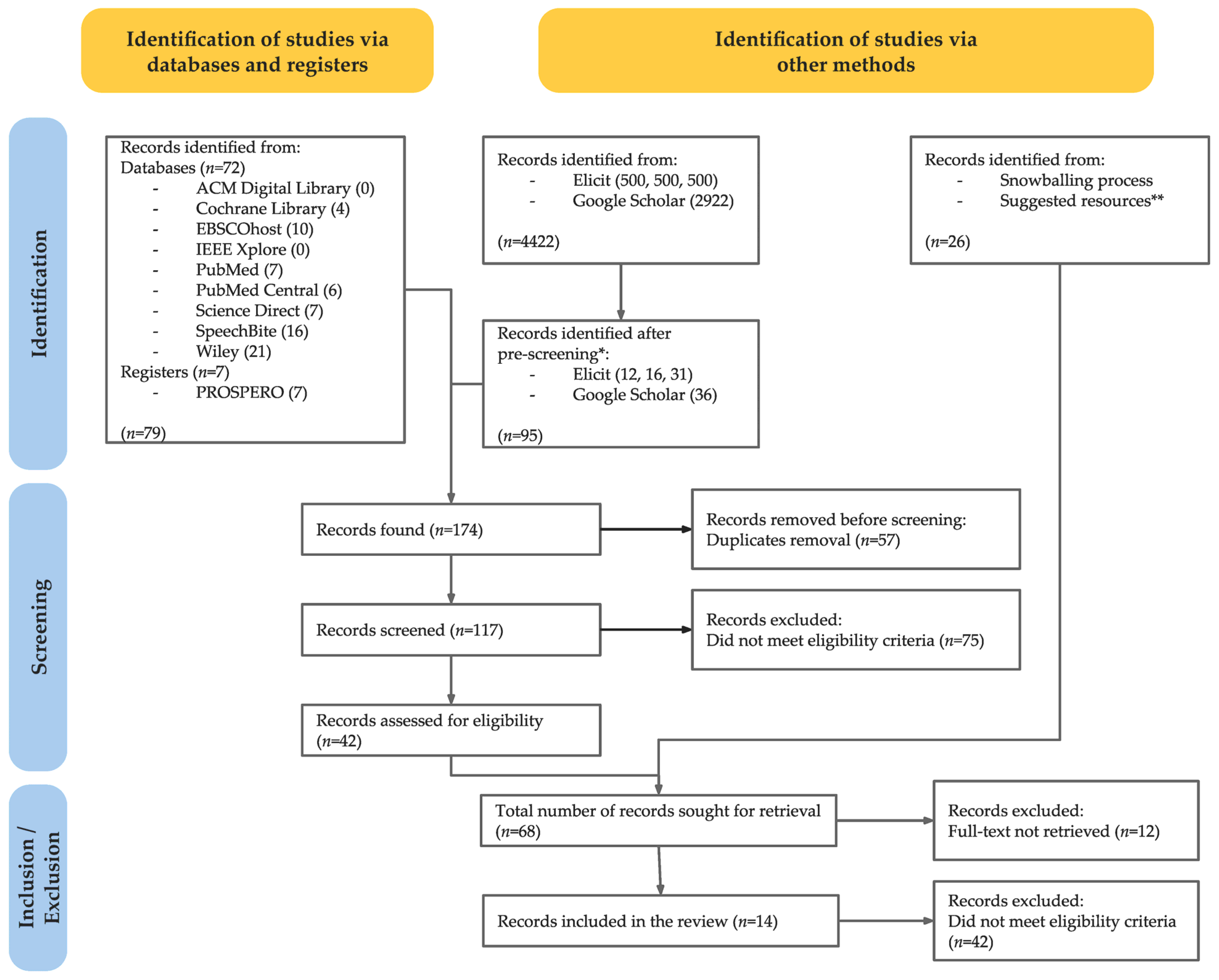
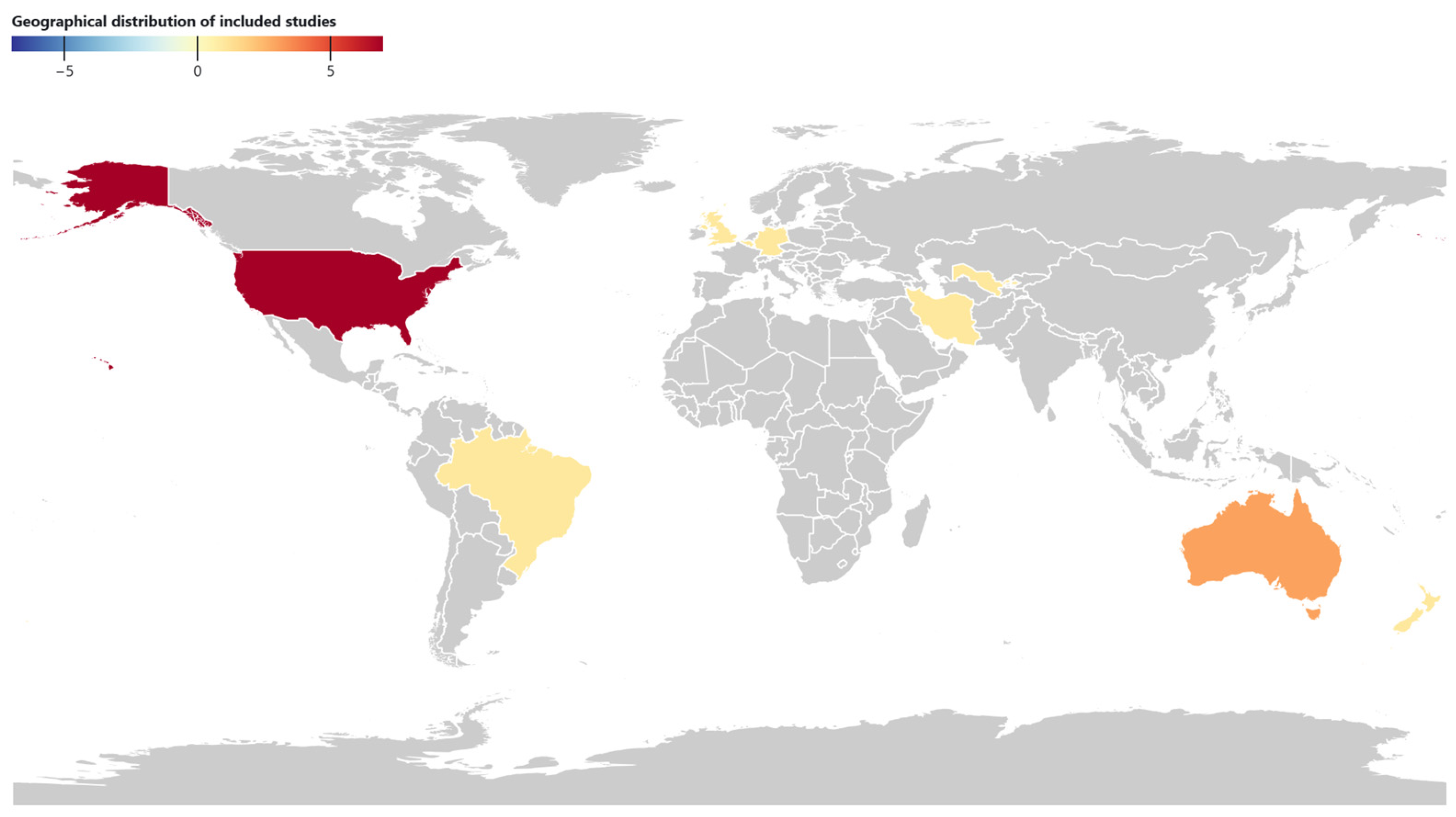
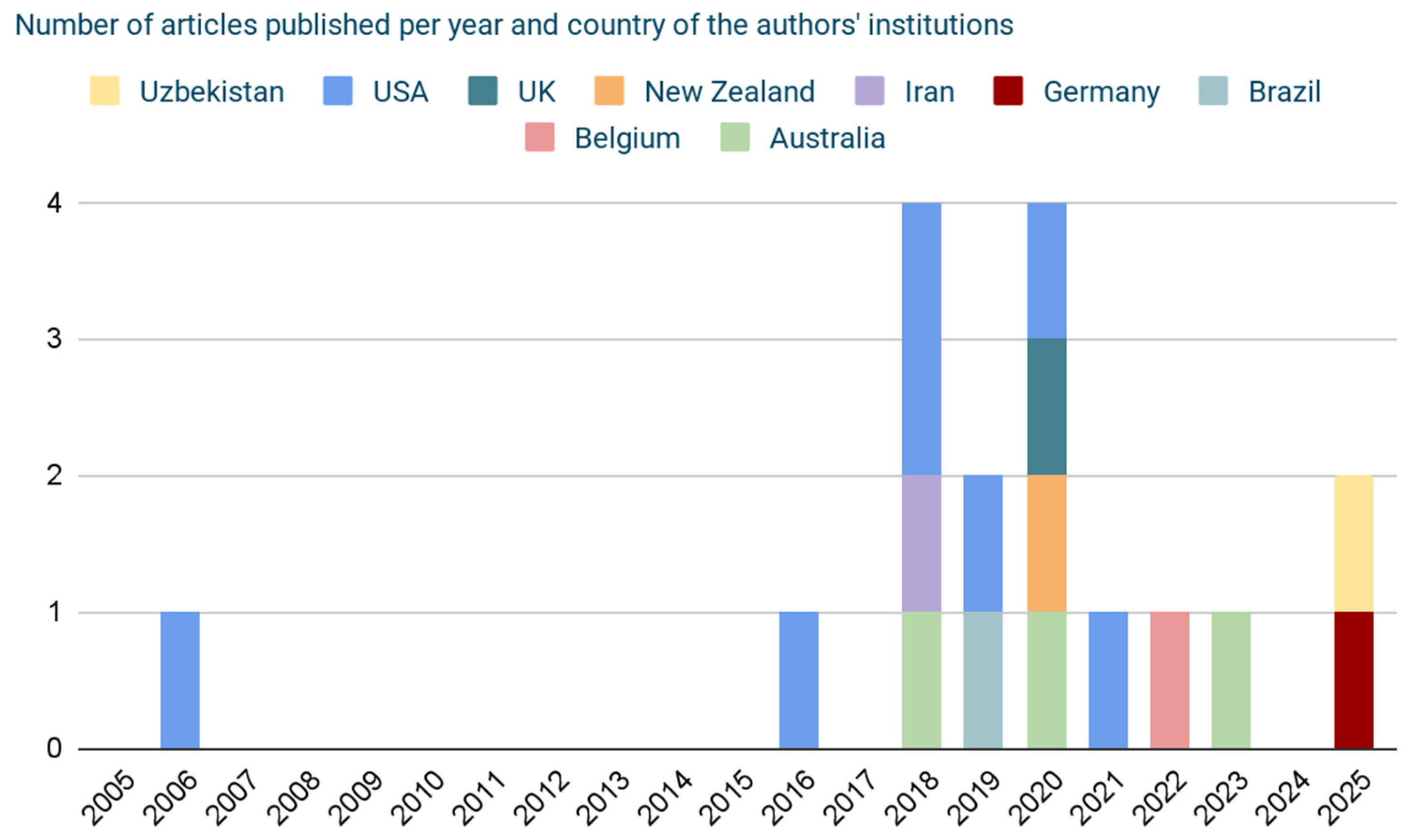
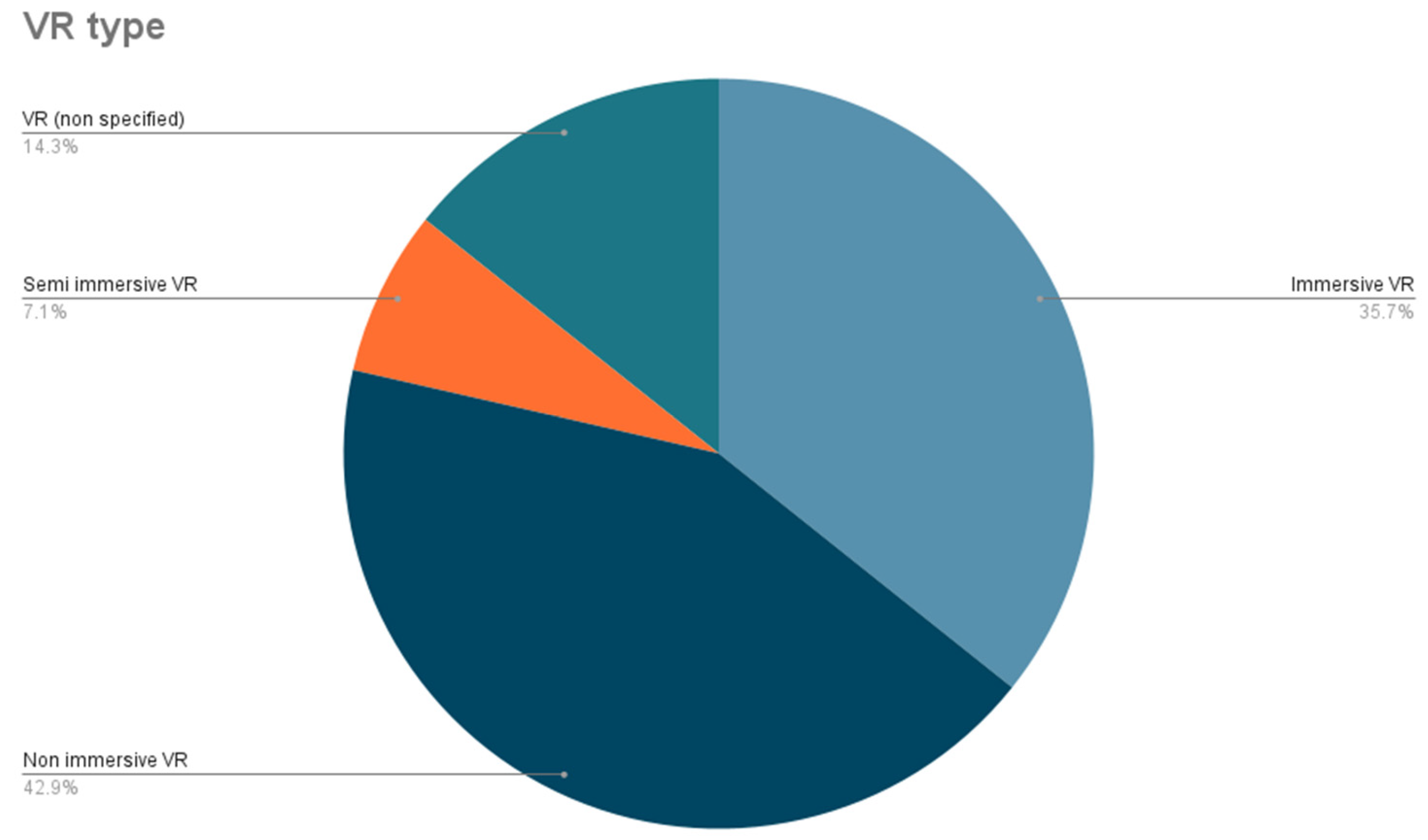
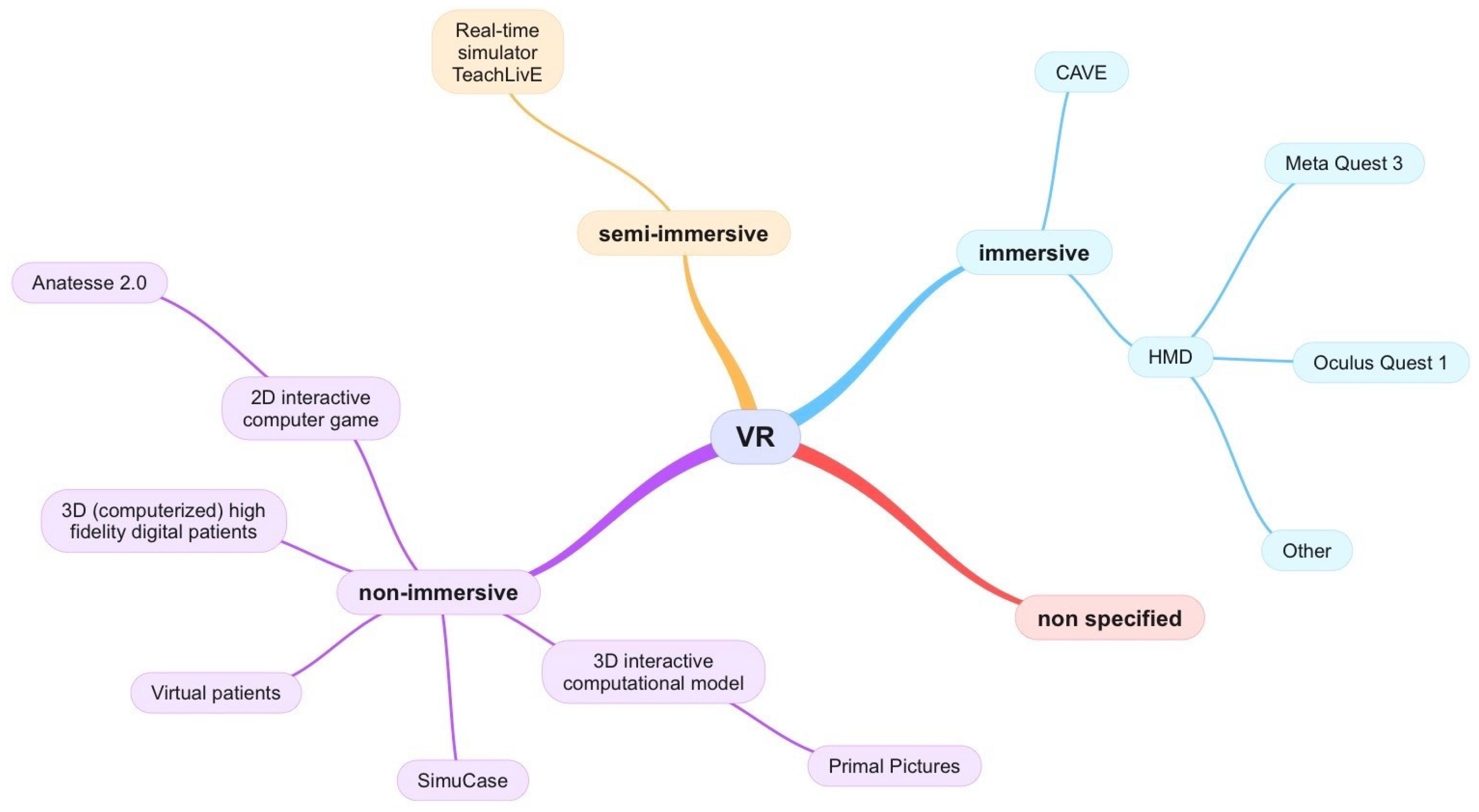
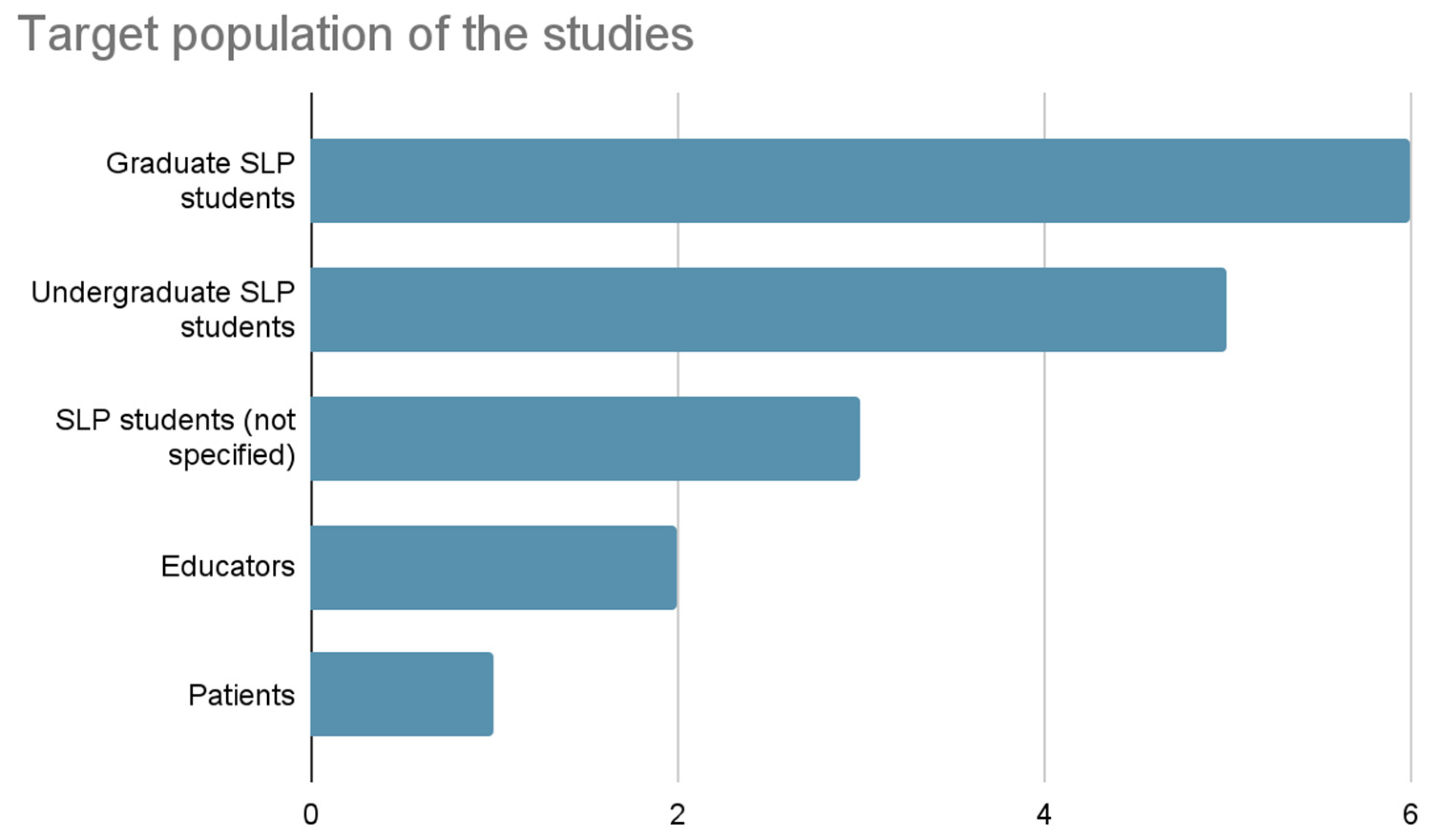
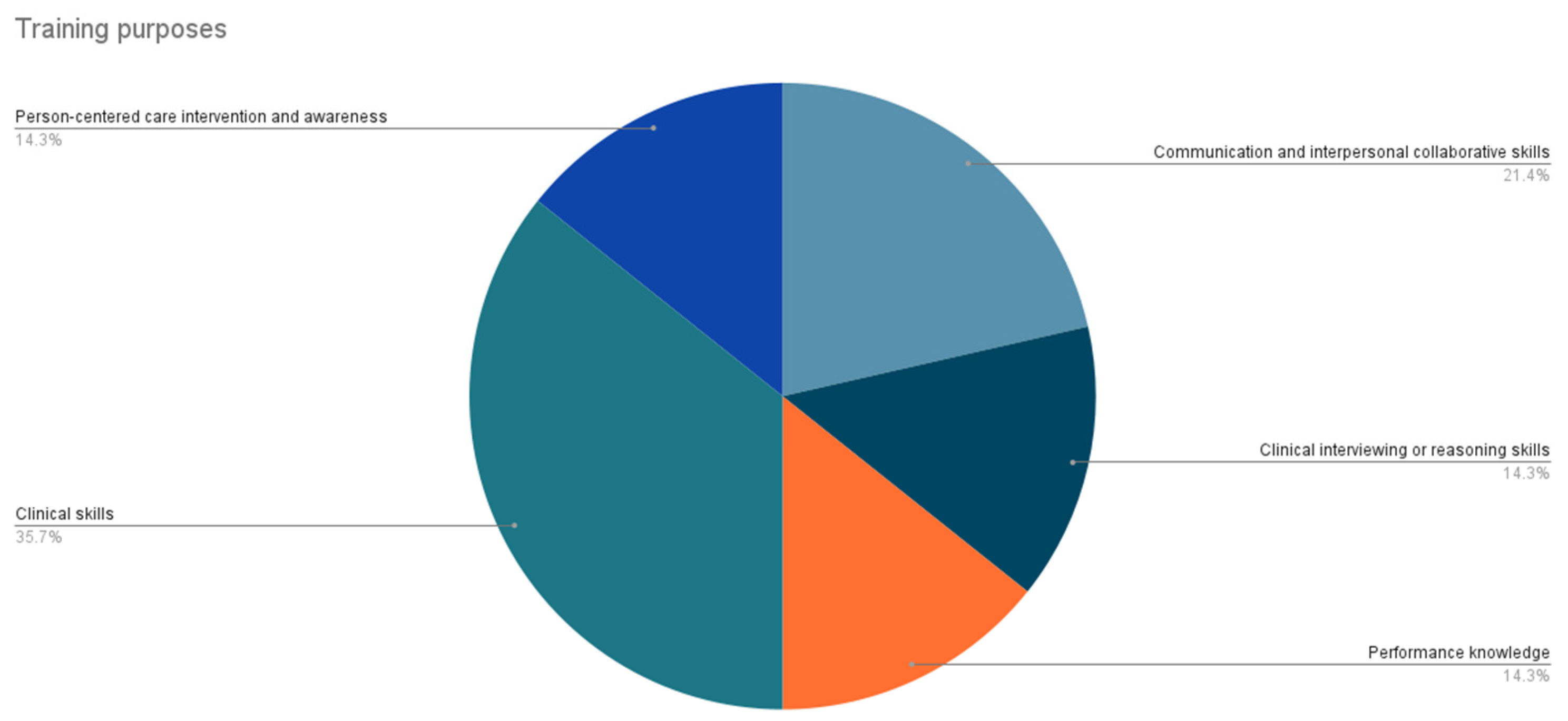
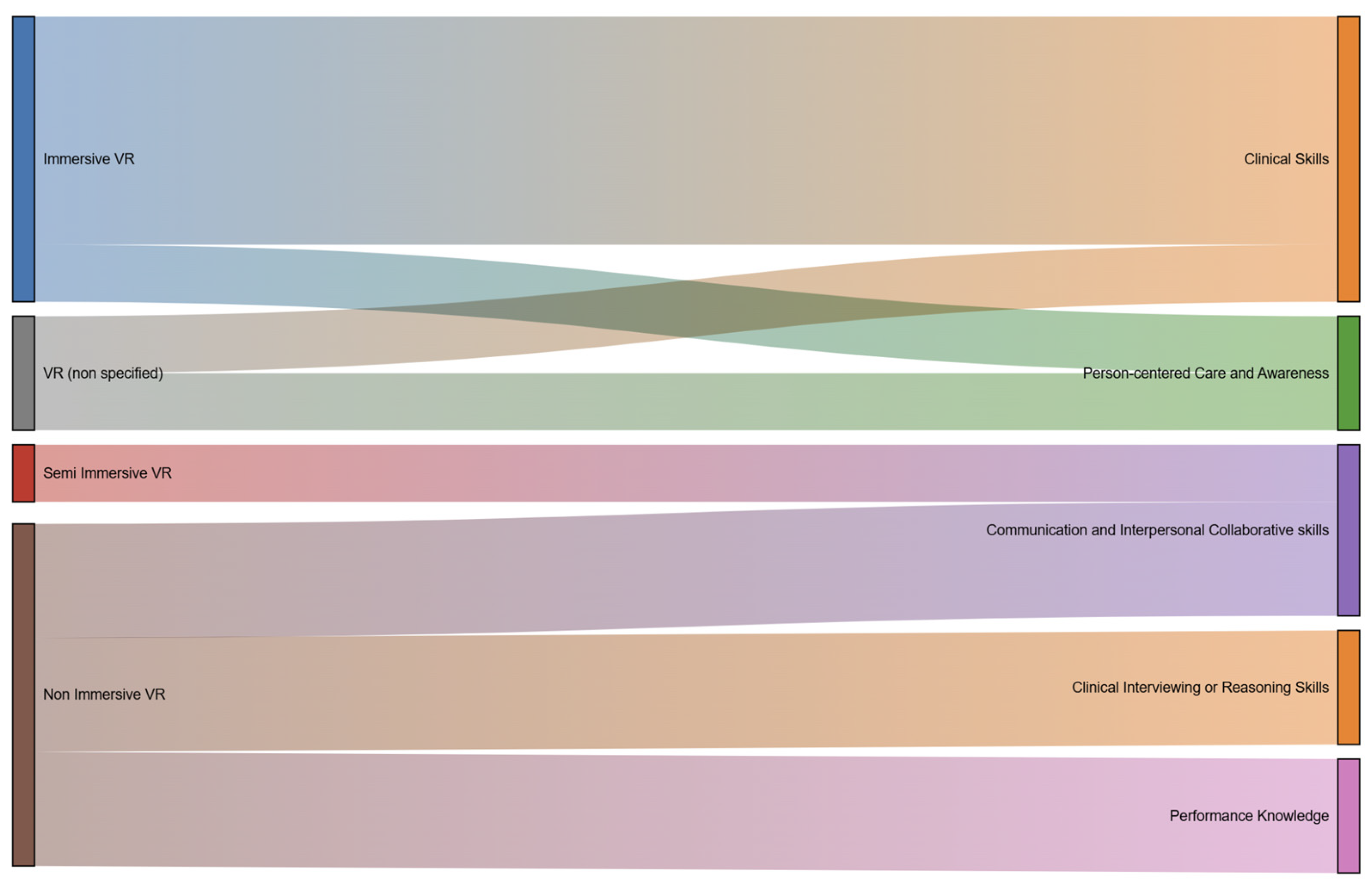
| Inclusion Criteria | Exclusion Criteria | |
|---|---|---|
| Study | All study types | Full-text not available |
| All languages | ||
| Every year | ||
| International studies | ||
| Full-text available (with or without a fee) | ||
| Population | Students and/or trainees in speech therapy | Students of general medical domain |
| Studies with mixed cohorts including speech therapy students and/or trainees | Students of general healthcare domain | |
| Exclusively speech therapy professionals | ||
| Concept | Virtual reality applications (immersive, semi-immersive, non-immersive) involved in the study | Exclusively AR |
| Exclusively desktop-based 2D applications | ||
| VR applications used as therapeutic or rehabilitative tool | ||
| Context | Education and training of students’ skills | Training of patients |
| Focus | Keywords |
|---|---|
| Population | speech therapy, speech-language therapy, SLT, speech pathology, speech-language pathology, SLP, logop * (i.e., logopedie, logopaedie, logopedics, logopaedics), student * (i.e., student, students) |
| Concept | VR, virtual reality |
| Context | training * (i.e., training, trainings), educat * (i.e., education, educational) |
| Title and Reference | Year | Country | Language | Study Type |
|---|---|---|---|---|
| The Virtual Immersion Center for Simulation Research: Interactive Simulation Technology for Communication Disorders [27] | 2006 | USA (Ohio) | en | Pilot |
| Virtual Patient Simulation Training in Graduate Dysphagia Management Education—A Research-Led Enhancement Targeting Development of Clinical Interviewing and Clinical Reasoning Skills [28] | 2016 | USA (Florida) | en | Mixed methods |
| A Clinical Educator’s Experience Using a Virtual Patient to Teach Communication and Interpersonal Skills [29] | 2018 | USA (Georgia) Australia | en | Qualitative |
| Oral Functional Assessment Training in Speech Therapy Students Using Virtual Reality (VR) [30] | 2018 | Iran | en | Descriptive |
| Impact of Virtual Simulation and Coaching on the Interpersonal Collaborative Communication Skills of Speech-Language Pathology Students: A Pilot Study [31] | 2018 | USA (Florida) | en | Pilot, Experimental |
| The Effects of Computer-Based Simulations on Speech-Language Pathology Student Performance [32] | 2019 | USA (Georgia) | en | Experimental |
| Efeitos Do Uso de Diferentes Tecnologias Educacionais Na Aprendizagem Conceitual Sobre o Sistema Miofuncional Orofacial [33] | 2019 | Brazil | en | Controlled randomised trial, Experimental |
| What Do Speech Pathology Students Gain from Virtual Patient Interviewing? A WHO International Classification of Functioning Disability and Health (ICF) Analysis [34] | 2020 | USA (Florida) New Zealand | en | Observational, Descriptive |
| Virtual Patient Clinical Placements Improve Student Communication Competence [35] | 2020 | Australia UK | en | Experimental |
| Effects of a Virtual Reality Dementia Experience on Graduate Communication Disorders Students’ Future Clinical Practice [36] | 2021 | USA (Kentucky) | en | Mixed methods (MA thesis) |
| Virtual Reality and Stuttering: A Tool for Experiential Learning in Preservice Speech Therapy Education [37] | 2022 | Belgium | en | Descriptive, Controlled randomised trial (poster presentation) |
| Speech Pathology Student Perspectives on Virtual Reality to Learn a Clinical Skill [38] | 2023 | Australia | en | Qualitative |
| Virtual Reality in Speech Therapy Training: Scenarios and Prototyping [39] | 2025 | Germany | en | Mixed methods, Design-based research |
| The Use of Information and Communication Technologies in Preparing Future Speech Therapists for Professional Practice [40] | 2025 | Uzbekistan | en | Mixed methods, Descriptive |
| Author(s) and Reference | VR Type | VR Characteristics | Population | Training Purposes (and Sub-Fields) | Main Outcomes and Assessment Methods |
|---|---|---|---|---|---|
| (Williams, 2006) [27] | Immersive VR | CAVE | Graduate SLP (and patients with communication disorders) | clinical skills | predicts increased competency and transfer of skills |
| projection-based technology | (communication disorders) | ||||
| (Sia et al., 2016) [28] | Non-immersive VR | Virtual Patients (VPP); immersive VP simulation | Graduate SLP | clinical interviewing and clinical reasoning skills | improvement of diagnosis competencies, reasoning and empathy; positive feedback |
| (stuttering) | |||||
| (Banszki et al., 2018) [29] | Non-immersive VR | Virtual Patients; immersive VP simulation | Undergraduate (3rd year); CE point of view | communication and interpersonal skills | improvement of CE confidence and pedagogical skills as educator |
| (Moradi et al., 2018) [30] | Immersive VR | 3D glasses + monitor + gloves | SLP students (5th term) | oral organs assessment training | increase in students’ scores |
| (Towson et al., 2018) [31] | Semi-immersive VR | mixed-reality real-time simulator TeachLivE | Graduate SLP (3rd semester) | interpersonal collaborative communication skills when delivering information regarding a singular patient to different stakeholders | performance enhancement (2nd attempt); collaborative |
| communication | |||||
| (Situation– | |||||
| Background– | |||||
| Assessment– | |||||
| Recommendation– | |||||
| Communication | |||||
| [SBAR-C]), high | |||||
| acceptability | |||||
| (Carter, 2019) [32] | Non-immersive VR | Virtual Patients; SimuCase; immersive VP simulation | Graduate SLP (2nd semester) | performances in paediatric language disorders | improved clinical skills, high levels of improvement on the SCSI and CTCSD |
| (Rondon-Melo & Andrade, 2019) [33] | Non-immersive VR | 2D interactive computer game (Anatesse 2.0); interactive 3D computational model (Primal Pictures) | Undergraduate students in Speech–Language and Hearing Sciences (SLHS) | anatomy and physiology of the orofacial myofunctional system | students’ performance in the knowledge assessment was similar, regardless of the learning method applied |
| (Miles et al., 2020) [34] | Non-immersive VR | Virtual Patients | Graduate final year | interviewing skills using WHO-ICF | ICF respected, matching health literacy; VP interviews and findings as assessment |
| (dysphagia) | |||||
| (Robinson et al., 2020) [35] | Non-immersive VR | 3D (computerised) high fidelity digital patients; immersive VP simulation | Undergraduate SLP (2nd year) | communication skills | improved communication competence; CCIS, PRQs as assessment method |
| (dementia) | |||||
| (Blaydes, 2021) [36] | VR (non specified) | non specified | Graduate SLP (2nd year) | understanding the importance of providing person-centred care | small margin for score improvement; increased levels of empathy |
| (dementia) | |||||
| (Deman et al., 2022) [37] | Immersive VR | not specified | BA SLP students | understanding stuttering-related anxiety | students reported fear and physiological fear responses |
| (Kelly et al., 2023) [38] | Immersive VR | VR-OMA application; Oculus Quest 1 | Undergraduate SLP (2nd year) | clinical skills | positive reaction of students’ intrinsic and extrinsic value for the training experience |
| (oral musculature assessment) | |||||
| (Gentile et al., 2025) [39] | Immersive VR | Meta Quest 3 applications implementing different scenarios | SLP | clinical skills | prototype development to be assessed through usability, presence, acceptance, user experience |
| (FEES, TTM, tDCS) | |||||
| (Xonbabayeva Madinabonu Asqarjon kizi, 2025) [40] | VR (non specified) | not specified | SLP students and educators | practical skills | enhanced understanding, skill acquisition, confidence and competence; interviews assessment |
Disclaimer/Publisher’s Note: The statements, opinions and data contained in all publications are solely those of the individual author(s) and contributor(s) and not of MDPI and/or the editor(s). MDPI and/or the editor(s) disclaim responsibility for any injury to people or property resulting from any ideas, methods, instructions or products referred to in the content. |
© 2025 by the authors. Licensee MDPI, Basel, Switzerland. This article is an open access article distributed under the terms and conditions of the Creative Commons Attribution (CC BY) license (https://creativecommons.org/licenses/by/4.0/).
Share and Cite
Gentile, F.; Wanke, M.; Mueller, W.; Hochuli, E. Virtual Reality in Speech Therapy Students’ Training: A Scoping Review. Virtual Worlds 2025, 4, 37. https://doi.org/10.3390/virtualworlds4030037
Gentile F, Wanke M, Mueller W, Hochuli E. Virtual Reality in Speech Therapy Students’ Training: A Scoping Review. Virtual Worlds. 2025; 4(3):37. https://doi.org/10.3390/virtualworlds4030037
Chicago/Turabian StyleGentile, Flavia, Mascha Wanke, Wolfgang Mueller, and Evi Hochuli. 2025. "Virtual Reality in Speech Therapy Students’ Training: A Scoping Review" Virtual Worlds 4, no. 3: 37. https://doi.org/10.3390/virtualworlds4030037
APA StyleGentile, F., Wanke, M., Mueller, W., & Hochuli, E. (2025). Virtual Reality in Speech Therapy Students’ Training: A Scoping Review. Virtual Worlds, 4(3), 37. https://doi.org/10.3390/virtualworlds4030037







